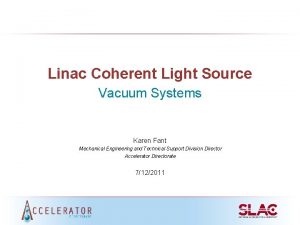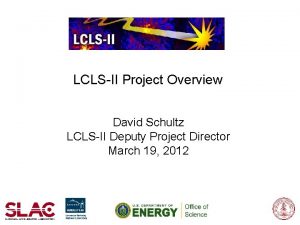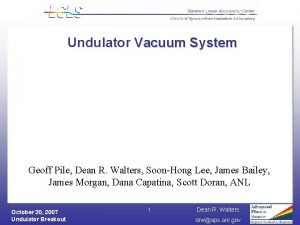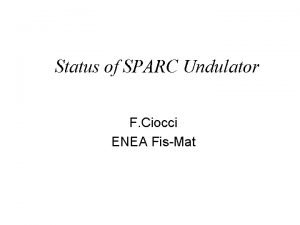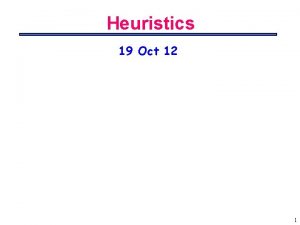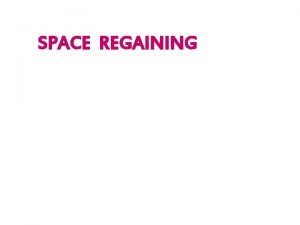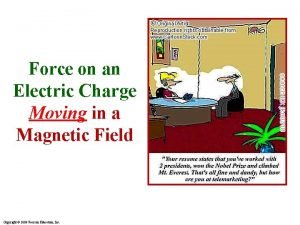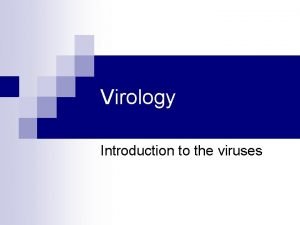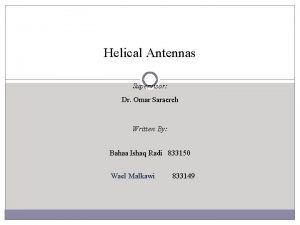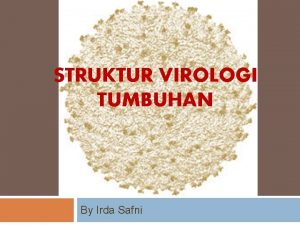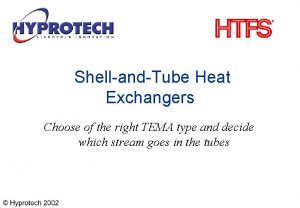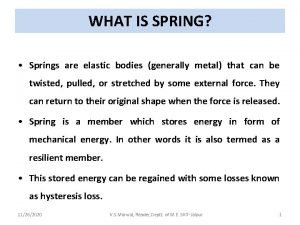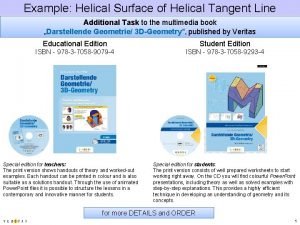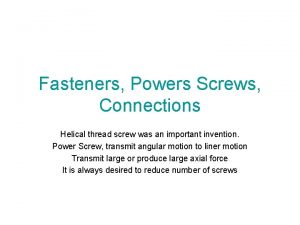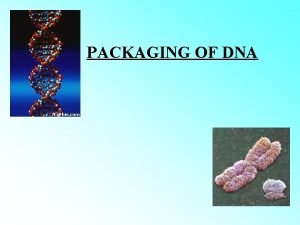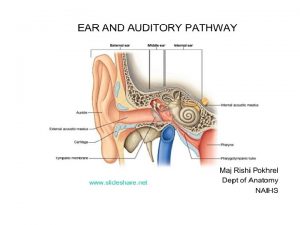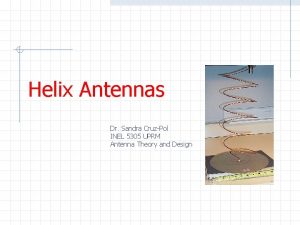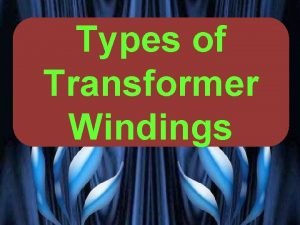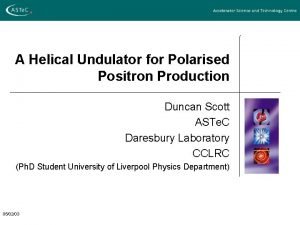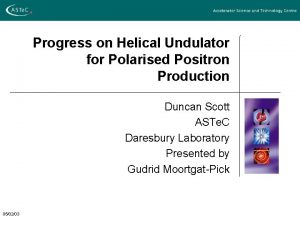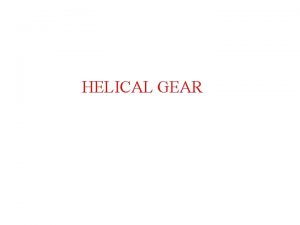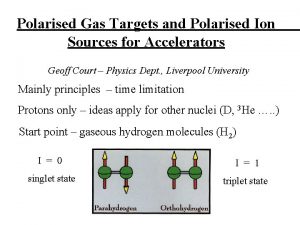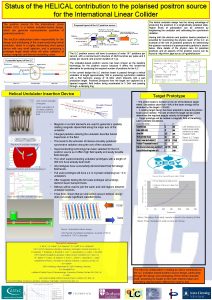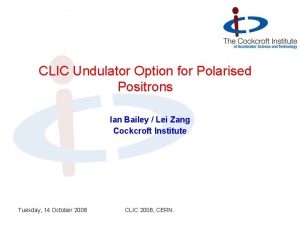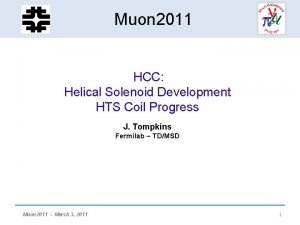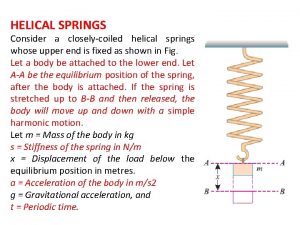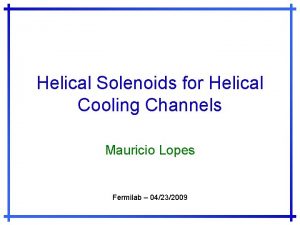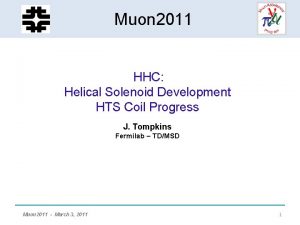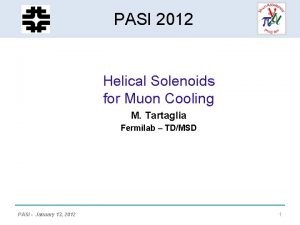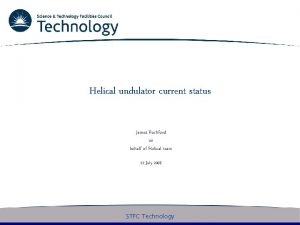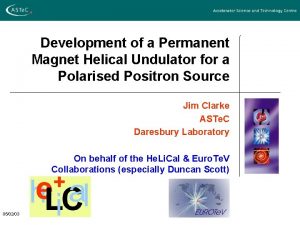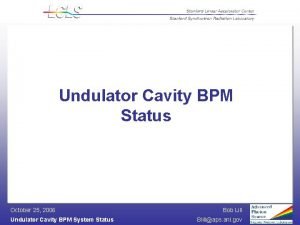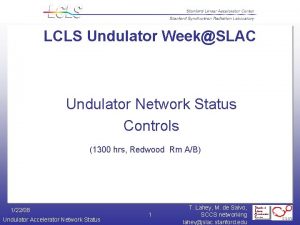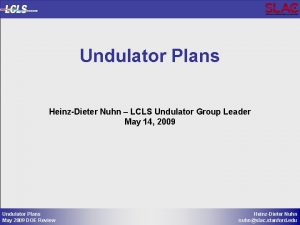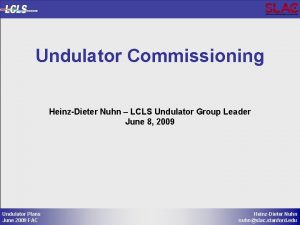WP 5 1 Helical Undulator for a Polarised




















- Slides: 20

WP 5. 1: Helical Undulator for a Polarised Positron Source Jim Clarke STFC Daresbury Laboratory On behalf of the He. Li. Cal collaboration 05/02/03

Positron Source Reminder Use main electron beam to generate photons Use photons to generate positrons (pairs) Helical undulator gives most photons per meter Helical undulator also generates polarised beam of positrons Positron generation system installed at 150 Ge. V point of main linac. LC-ABD April 2007 Jim Clarke 2

Undulator Challenges l High fields § l Short Periods § l Must not degrade electron beam properties but have to remove energy from electrons Creating a vacuum § l Cannot tolerate more than few W of heating per module Minimising impact on electron beam § l Very tight tolerances - Alignment critical Cold bore (4 K surface) § l Shorter periods imply higher fields Narrow apertures § l Pushing the limits of technology Impossible to use conventional pumps, need other solution Minimising cost § Minimise total length, value engineering LC-ABD April 2007 Jim Clarke 3

Recent Highlights l Two 12 mm period SC undulator prototypes built and tested § § § l One 11. 5 mm period SC undulator built and tested § § § l 4 m prototype design complete Fabrication has commenced GDE Involvement § § § l Period further reduced to RDR value of 11. 5 mm New SC wire used (more SC and less Cu) Field strength measured greater than expected, possibly due to increase in SC content of wire Best ever field quality results (well within spec) Full length prototype will use these parameters Full length prototype construction started § § l Period reduced to 12 mm from 14 mm Better, more reproducible, fabrication technique Full inclusion of iron for the first time Reviewing the positron source costings Contributing to the RDR Positron Source workshop hosted by CCLRC at RAL Undulator impact studies ongoing § Emittance growth due to misalignments & wakefields shown to be <2% Paper on undulator technology choice published by Phys. Rev. ST-AB LC-ABD April 2007 Jim Clarke l Paper on vacuum issues submitted to JVSTA l 4

UK Prototypes I II IV V Former material Al Al Al Iron Period, mm 14 14 12 12 11. 5 rectangular trapezoidal rectangular Winding bore, mm 6 6 6. 35 Vac bore, mm 4 4. 5 (St Steel tube) 5. 23* (Cu tube) Winding 8 -wire ribbon, 8 layers 9 -wire ribbon, 8 layers 7 -wire ribbon, 8 layers Sc wire Cu: Sc 1. 35: 1 Cu: Sc 0. 9: 1 Status Completed and tested Completed, tested and sectioned Completed and tested Groove shape LC-ABD April 2007 Jim Clarke 5

Prototype 5 l l l Same parameters as RDR Baseline undulator 11. 5 mm period 6. 35 mm winding diameter Peak on-axis field spec of 0. 86 T (10 Me. V photons) Winding directly onto copper tube with iron pole and yoke New wire with more aggressive Cu: SC ratio of 0. 9: 1. 0 LC-ABD April 2007 Jim Clarke First 500 mm long prototype 6

Measurements for Prototype 5 1 st results from prototype 5 at RAL Measured field at 200 A 0. 822 T +/- 0. 7 % (spec is +/- 1%) Prototype 5 details Period : 11. 5 mm Magnetic bore: 6. 35 mm Configuration: Iron poles and yoke LC-ABD April 2007 Quench current 316 A Equates to a field of 1. 1 T in bore RDR value is 0. 86 T 80% of critical current (proposed operating point) would be 0. 95 T Jim Clarke 7

Summary of Prototype Results Fe former & yoke Prototype 5 @ 250 A Fe former @ 200 A Aluminium former LC-ABD April 2007 Jim Clarke 8

Specification for 4 m Undulator Module On axis field 0. 86 T Peak to peak variation <1% Period 11. 5 mm Nominal Current ~250 A Nom current as % of Short Sample 80% SC wire Nb. Ti 0. 4 mm dia. , SC: Cu ratio 0. 9: 1 Winding Cross Section 7 wires wide x 8 high Number of magnets per module 2 (powered separately for tests) Length of magnetic field 2 x 1. 74 m No Beam Collimators or Beam Pipe Vacuum pumping ports in the magnet beam pipe 9

4 m Prototype Module Stainless steel vacuum vessel with Central turret 50 K Al Alloy Thermal shield. Supported from He bath U beam Support rod Stainless Steel He bath filled with liquid Helium. Magnet support provided by a stiff U Beam Tube Construction has started, will be complete by Autumn 07 LC-ABD April 2007 Jim Clarke Superconducting Magnet cooled to 10 4. 2 K

Magnet Design Concept Steel Yoke. Provides 10% increase in field and mechanical support former Winding pins PC board for S/C ribbon connections Steel yoke 2 start helical groove machined in steel former Cu beam pipe, with conductor wound on to tube OD LC-ABD April 2007 Jim Clarke 11

Winding Machine Custom built winding machine. Maximum winding length 2 m. Period 8 to 15 mm LC-ABD April 2007 Jim Clarke 12

Cryostat Turret Cryocooler 50 K Thermal shield Liq He Condensing pot. Cooled to 4. 5 K from cooler second stage He vent pipe He bath Top plate 4 off HTC current leads. Cooled to 50 K from cooler 1 st stage LC-ABD April 2007 Instrumentation feedthrough Jim Clarke 13

Support systems Two support System required – 1. 2. U Beam within He bath (Shown) He Bath within vacuum vessel Conceptually the two systems are identical – Adjustable in X and Y to allow the beam pipe to be centred within the vacuum vessel. Fixed at the magnet mid position to allow for thermal contractions of ~6 mm at each end. LC-ABD April 2007 Jim Clarke 14

Cold to Warm Transition Tapered stainless steel tube Thermal shield, 60 K He Bath, 4 K Shielded bellows Copper taper LC-ABD April 2007 Clarke 4 m Module will be fully compatible with. Jim insertion into an electron beam test line 15

Alternative Scheme Unshielded bellows Wakefield impact of both schemes now under study ECHO code being used as well as analytical studies Modelling of pumping slots not yet resolved New taper arrangement Results will help set alignment tolerances Expect total vertical emittance growth to be <1% LC-ABD April 2007 Jim Clarke 16

Transverse Wakefields l l l These have been calculated for the narrow aperture vacuum vessels Longitudinal effects have been reported previously Results found for 3 ILC parameter sets: LC-ABD April 2007 Jim Clarke 17

Wake for Different Materials l l l Wake calculated at 2. 925 mm radius vessel 77 K assumed (difficult to find material data at 4 K) The vessel will be copper so 0. 27 e. V/mm/m is worst case 150 mm bunch 300 mm bunch 500 mm bunch LC-ABD April 2007 Jim Clarke 18

Emittance Increase Due to Transverse Wakes l Undulator Lattice l No emittance change due to transverse wakes (safety margin high, no effect until kick strength x ~5000) This work has led onto modelling of errors within the lattice l § § § Input trajectory error Quadrupole misalignments BPM to Quad misalignments LC-ABD April 2007 Jim Clarke 19

Summary l l l l Five SC prototypes have been successfully built and tested The RDR undulator specification has been exceeded by the latest prototype The 4 m long module will use the same magnet parameters 4 m long module design complete and construction started UK continues to have major GDE involvement in positron source and has world leading position on undulator system Undulator interactions with electron beam continue, no serious problems identified so far, many issues now resolved Paper on undulator technology choice published by Phys. Rev. ST-AB § l http: //prst-ab. aps. org/abstract/PRSTAB/v 10/i 3/e 032401 Paper on vacuum issues submitted to JVSTA LC-ABD April 2007 Jim Clarke 20
 Undulator
Undulator Undulator
Undulator Chain clamp
Chain clamp Undulator
Undulator Helical ribbon mixer
Helical ribbon mixer Hawley's appliance with helical space regainer
Hawley's appliance with helical space regainer Helical path
Helical path Helical virus
Helical virus Helical antenna gain
Helical antenna gain Helical motion
Helical motion Brome mosaic virus
Brome mosaic virus Split backing ring heat exchanger
Split backing ring heat exchanger Helical spring formula
Helical spring formula Helical surface
Helical surface Helical thread screw
Helical thread screw Tight helical fiber
Tight helical fiber Crus helix
Crus helix Inel uprm
Inel uprm Helical winding in transformer
Helical winding in transformer Steg för steg rita
Steg för steg rita Fspos vägledning för kontinuitetshantering
Fspos vägledning för kontinuitetshantering
